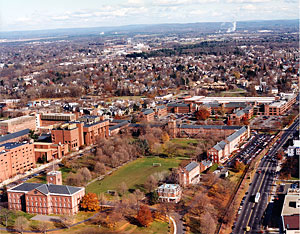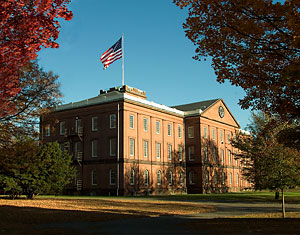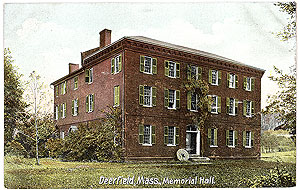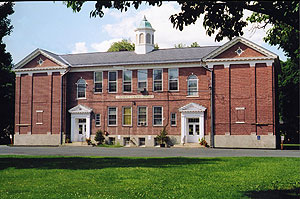About This Site
About This Project
The Shays’ Rebellion website is the result of a collaboration among Springfield Technical Community College (STCC), the Springfield Armory, and the Pocumtuck Valley Memorial Association (PVMA).
Springfield Technical Community College

Springfield Technical Community College (STCC)] is located on the 55-acre Springfield Armory National Historic Site. In 1789, George Washington selected this site for the nation’s first armory; Springfield Armory was established by Congress in 1794. This location is the actual historic site where the Shays’ Rebellion assault on the Springfield Arsenal occurred; consequently the College has a special commitment to the preservation and the communication of the significance of this historic site. In 2004 a new president, Dr. Ira Rubenzahl, made raising the profile of humanities programs a top institutional goal. The 220th- 225th anniversary period of Shays’ Rebellion fits well with STCC’s goals of increasing its programs, capacity and leadership in the area of the humanities.
Springfield Technical Community College is the only “technical” college in the Massachusetts community college system. Founded in 1967, STCC serves close to 6,000 credit students annually who enroll, not only in career educational programs, but also in baccalaureate transfer programs. Annually, over 600 students are liberal arts majors, while about 150 students are enrolled in its Teacher Education Program. The College has a strong Honors Program, recognized by the State of Massachusetts as exemplary. STCC is known for its career programs in health, engineering technologies, and business, offering one of the widest selections by a community college in New England. Programs ranging from laser electro-optics technology to nuclear medicine attract students to studies that are uncommon in this region.
Located in the urban heart of Massachusetts’ third-largest city, STCC serves a diverse social, economic and racial mix of students. Generally two-thirds of the student body receives financial aid, and one-third are minority students. STCC supports 48% of its expenditures from state funds. The operating budget of $51 million is also supported from student fees, private contributions and federal grants. Second to personnel and instructional equipment is the cost to maintain its 34-acre campus, a designated National Historic Site. STCC manages over $5 million in federal funds annually, including grants of over $1 million from the National Science Foundation.
One hundred fifty-seven of STCC’s faculty teach full-time. Part-time faculty include clinical faculty who guide health students in their practicum experiences at area hospitals, medical centers, and other healthcare facilities. Because of the College’s many career programs, as well as the computer and professional development workshops offered by the Center for Business and Technology, STCC is a major source of trained employees for business and industry throughout the region.
The nature of STCC—a technical college, located in an historic site in the urban core—has led to the development of programs that are somewhat unique. The School of Arts, Humanities and Social Sciences, consisting of approximately 40 full-time and 40 part-time professors and instructors, boasts both core United States history courses as well as an interesting mix of multi-ethnic courses. Moreover, the history faculty has engaged students in independent research projects and internships that promote interaction with City museums, including the Springfield Armory Museum.
The NEH Award for the Shays’ Rebellion Website
In September, 2006, STCC was awarded a $240,990 We The People (WTP) grant from the National Endowment for the Humanities (NEH) to develop the Shays’ Rebellion & the Making of a Nation website. Of the 155 applications received by the Division of Public Programs in the grant cycle in which STCC competed, only 32 received funding. Only 16 of the projects receiving support were designated as WTP projects. STCC’s was the only stand-alone website that received funding (let alone WTP status) in this round of competition. No other community colleges received grants from this division in this cycle.
STCC competed in a grant category known as Special Projects. In this category, 25 applications were received and 5 received funding. Of the five receiving support, none received more money than STCC; two other institutions, the Chicago Historical Society and Northern Arizona University, received the same amount. STCC competed with some of the foremost cultural institutions in the nation. Among the others receiving support in this round were Old Sturbridge Village; the Museum of Fine Arts, Boston; UCLA’s Fowler Museum of Cultural History; the Princeton University Art Museum; the Children’s Museum of Indianapolis; and the Denver Art Museum.
STCC is partnerned with six different community colleges throughout the United States to promost and publicize the website: Bismarck State College, Bismarck, ND; Brookhaven College, Dallas, TX; Cuyamaca College, El Cajon, CA; Sheridan College, Sheridan, WY; York Tech College, Rockhill, SC; and Westfield State College, Westfield, MA.
Springfield Armory

STCC’s historic campus includes the actual site of Shays’ Rebellion and consists of 27 buildings; the oldest was constructed in 1807. Steeped in history, the College shares the campus with the Springfield Armory Museum. The United States Congress established the Springfield Arsenal in 1777. An arsenal stores, but does not manufacture arms. The Arsenal became the Springfield Armory in 1794 when George Washington selected the site for the nation’s first armory—a site for the manufacturing, as well as the storing of firearms. In its long history, the Springfield Armory was the center for research, development, and the manufacturing of most of the small arms that American soldiers depended upon. Manufacturing innovations at the Armory, with its skilled workers, spread throughout the Connecticut River Valley, creating a region known for precision manufacturing. After WWII, production decreased at the Armory, and in 1964, the government announced the phase-out of the historic installation; it closed as an Armory in 1968. Congress established the Springfield Armory as a National Historic Site in the mid-1970’s.
The mutually beneficial co-location of the Springfield Armory Museum and STCC on the same site permits a creative atmosphere in which scholars can contemplate a range of topics, most notably the history of industrial technology from 1794 to the present day. The entire site receives more than 35,000 visitors annually. The Armory’s website section “History and Culture” provides material on Shays’ Rebellion, titled The Last Battle of the American Revolution
Pocumtuck Valley Memorial Association (PVMA)

The Pocumtuck Valley Memorial Association is STCC’s major partner organization for the Shays’ website project. PVMA brings a wealth of knowledge and experience on public history programs, Shays’ Rebellion and American history and website programs. The Pocumtuck Valley Memorial Association is one of the oldest history museums in New England. Its mission is to preserve and communicate the multicultural history of the Connecticut and Deerfield River Valleys, a region stretching from Springfield and the border of Connecticut, north to Vermont. PVMA collects, preserves, and exhibits historic artifacts and documents and interprets them in the wider context of regional, U.S., and world history.
PVMA was founded in 1870 with the goal of "memorializing" the past. PVMA opened Memorial Hall in 1880 as the first historical museum in western Massachusetts. Now a regional museum, PVMA has an interest in the entire scope of New England history stretching from the ancestral peoples of the Pocumtucks to the early 20th century, with diverse regional and national audiences. The museum library, jointly administered with that of Historic Deerfield, Inc., is a premier research facility.
PVMA offers a wide variety of programs including interpretive exhibits, living history events, publications, multi-faceted public and education programs, and web-based education and exhibit offerings. PVMA has acquired exceptional expertise in historical website programs; it has created two award-winning websites, American Centuries: A View from New England, an educational website using historic documents and objects as a window into understanding American history, and Raid on Deerfield: The Many Stories of 1704, which has received accolades for its engaging and innovative approaches. PVMA is also home to the Deerfield Teachers’ Center.

PVMA’s collections include over 70,000 objects and documents, spanning pre-history through the 20th century, with an especially rich collection from the Confederation Period, as well as many documents and artifacts directly related to Shays’ Rebellion. A remarkable feature of the collection is the depth of the documentation of its objects within the curatorial files, as well as interrelated journals and newspapers in the library. Combining the early printed and manuscript resources of the library with objects in the museum provides a unique opportunity to teach history with a national and international overview.
The library holds nearly 25,000 printed books and pamphlets and 900 linear feet of manuscripts, which represent to an extraordinary degree, the life and thought of one region from the close of the 17th century to the opening of the 20th century. The collections include manuscripts from towns involved in Shays’ Rebellion and a full collection of period newspapers reporting on the event. The museum’s collection of over 35,000 objects includes a full array of artifacts, such as clothing, household items, tools, and military artifacts, which illustrate life during the Confederation Period.